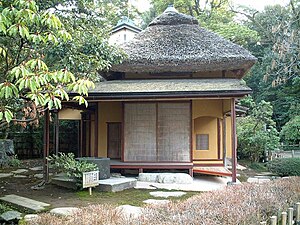Wabi-sabi
From Wikipedia, the free encyclopedia


Wabi-sabi (侘寂 ) represents a comprehensive Japanese world view or aesthetic centered on the acceptance of transience. The phrase comes from the two words wabi and sabi. The aesthetic is sometimes described as one of beauty that is "imperfect, impermanent, and incomplete" (according to Leonard Koren in his book Wabi-Sabi: for Artists, Designers, Poets and Philosophers). It is a concept derived from the Buddhist assertion of the Three marks of existence (三法印 sanbōin), specifically impermanence (無常 mujō). Note also that the Japanese word for rust, 錆 is also pronounced sabi (the borrowed Chinese character is different, but the word itself is of assumed common etymology), and there is an obvious semantic connection between these concepts.[citation needed]
Characteristics of the wabi-sabi aesthetic include asymmetry, asperity, simplicity, modesty, intimacy, and suggest a natural process.
Contents |
[edit] Description
According to Koren, wabi-sabi is the most conspicuous and characteristic feature of what we think of as traditional Japanese beauty and it "occupies roughly the same position in the Japanese pantheon of aesthetic values as do the Greek ideals of beauty and perfection in the West." Andrew Juniper claims, "if an object or expression can bring about, within us, a sense of serene melancholy and a spiritual longing, then that object could be said to be wabi-sabi." Richard R. Powell summarizes by saying "It (wabi-sabi) nurtures all that is authentic by acknowledging three simple realities: nothing lasts, nothing is finished, and nothing is perfect."
The words wabi and sabi do not translate easily. Wabi originally referred to the loneliness of living in nature, remote from society; sabi meant "chill", "lean" or "withered". Around the 14th century these meanings began to change, taking on more positive connotations.[1] Wabi now connotes rustic simplicity, freshness or quietness, and can be applied to both natural and human-made objects, or understated elegance. It can also refer to quirks and anomalies arising from the process of construction, which add uniqueness and elegance to the object. Sabi is beauty or serenity that comes with age, when the life of the object and its impermanence are evidenced in its patina and wear, or in any visible repairs.
From an engineering or design point of view, "wabi" may be interpreted as the imperfect quality of any object, due to inevitable limitations in design and construction/manufacture especially with respect to unpredictable or changing usage conditions; then "sabi" could be interpreted as the aspect of imperfect reliability, or limited mortality of any object, hence the etymological connection with the Japanese word sabi, to rust.
A good example of this embodiment may be seen in certain styles of Japanese pottery. In Japanese tea ceremony, cups used are often rustic and simple-looking, e.g. Hagi ware, with shapes that are not quite symmetrical, and colors or textures that appear to emphasize an unrefined or simple style. In reality, the cups can be quite expensive and in fact, it is up to the knowledge and observational ability of the participant to notice and discern the hidden signs of a truly excellent design or glaze (akin to the appearance of a diamond in the rough). This may be interpreted as a kind of wabi-sabi aesthetic, further confirmed by the way the glaze is known to change in color with time as tea is repeatedly poured into them (sabi) and the fact that the cups are deliberately chipped or nicked at the bottom (wabi), which serves as a kind of signature of the Hagi-yaki style.
Wabi and sabi both suggest sentiments of desolation and solitude. In the Mahayana Buddhist view of the universe, these may be viewed as positive characteristics, representing liberation from a material world and transcendence to a simpler life. Mahayana philosophy itself, however, warns that genuine understanding cannot be achieved through words or language, so accepting wabi-sabi on nonverbal terms may be the most appropriate approach.
The wabi and sabi concepts are religious in origin, but actual usage of the words in Japanese is often quite casual. The syncretic nature of Japanese belief systems should be noted.
[edit] Wabi-sabi in Japanese arts
Many Japanese arts over the past thousand years have been influenced by Zen and Mahayana philosophy, particularly acceptance and contemplation of the imperfection, constant flux, and impermanence of all things. Such arts can exemplify a wabi-sabi aesthetic. Here is an incomplete list:
- honkyoku (traditional shakuhachi music of wandering Zen monks)
- ikebana (flower arrangement)
- Japanese gardens, Zen gardens, and bonsai (tray gardens)
- Japanese poetry, particularly haiku
- Japanese pottery, notably Hagi ware
- Japanese tea ceremony
- Bonsai the Japanese art of miniature trees
[edit] Western use
Former Stuckist artist and remodernist filmmaker Jesse Richards employs it in nearly all of his work, along with mono no aware.
During the 1990s the concept was borrowed by computer software developers and employed in Agile programming and Wiki to describe acceptance of the state of ongoing imperfection that is the product of these methods.[2]
On 16 March 2009, Marcel Theroux presented 'In Search of Wabi-sabi' on BBC Four as part of the channel's 'Hidden Japan' season of programming. Marcel travelled throughout Japan trying to understand the aesthetic tastes of Japan and its people.
[edit] See also
- Iki (a Japanese aesthetic ideal)
- Mono no aware
- Wabi-cha
- Clinamen
[edit] References
- ^ Koren, Leonard (1994). Wabi-Sabi for Artists, Designers, Poets and Philosophers. Stone Bridge Press. ISBN 1-880656-12-4.
- ^ "Wabi Sabi". http://c2.com/cgi/wiki?WabiSabi. Retrieved on 2006-11-19.
- Juniper, Andrew (2003). Wabi Sabi: The Japanese Art of Impermanence. Tuttle Publishing. ISBN 0-8048-3482-2.
- Powell, Richard R. (2004). Wabi Sabi Simple. Adams Media. ISBN 1-59337-178-0.
- Crowley, James and Sandra (2001). Wabi Sabi Style. Gibbs Smith, Publisher. ISBN 1-58685-753-3.
- "General Remarks on Japanese Art Culture" in Suzuki, Daisetz T. (1959). Zen and Japanese Culture. ISBN 1-56731-124-5.


